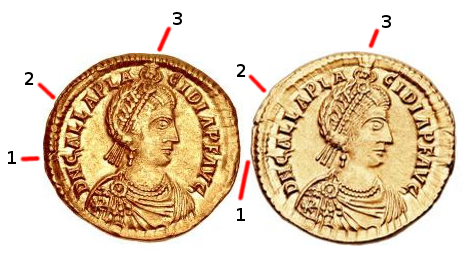VOT XX MVLT XXX
Bust of Galla Placidia to the right, draped with Chi-Rho on right shoulder, wearing a diadem of pearls, a double necklace of pearls and long earrings. Above, the hand of God crowning her.
An angel standing left and holding a long Latin cross adorned with jewels. A star above the angel.
Marks
Photo of a coin sold the 10/04/2014 by Heritage Auctions, Auction 3032, lot 23742, link to the sale and their website: https://coins.ha.com/itm/ancients/roman-imperial/ancients-galla-placidia-wife-of-constantius-iii-mother-of-valentinian-iii-augusta-ad-421-450-av-solidus-22mm-/a/3032-23742.s?type=acsearch3032.
The only difference between the AYC #10, RIC 2007 and the AYC #10 obv. link, RIC 2007 is the obverse die. Indeed, the RIC X mentions that the RIC 2007 has the same obverse die as a coin minted in Aquileia. This coin is therefore linked by its obverse to the AYC #2 obv. link, RIC 1808. I notice that the coin shown here also shares the same reverse die as the coin shown in the RIC X plate 48 n°2007. I note that quite disturbingly, the centering as well as the striking angle seem almost perfectly similar..
The obverse die when striking for this coin is more worn than when striking the coin of Aquileia. Below are the elements showing the breakage and flattening of the coin appearing on the Rome coin (on the right of the image):

Coin on the left: Photo of a coin sold the 07/01/2014 by Classical Numismatic Group, Triton XVII, lot 816, link to the sale: https://www.acsearch.info/search.html?id=1825607, link to their website: https://www.cngcoins.com/.
1: Die break linking the letter G to the beading.
2: Die break going from the beading to the letter L.
3: Flattening of the beading. Extension of the hand of God in the beading?
Point 3 is very interesting. Indeed, on the coin of Aquileia, the beading is prominent while it is flat on the coin of Rome, but again in addition there is a new extension of the hand of God. Was there a slight re-engraving when the die arrived in Roma? All this in any case confirms the working dates of the mints given by the RIC: May to October 425 for Aquileia and 425-6 for Roma..
All Solidi of all types and in all mints (except the one in Constantinople) always display a double pearl necklace. Except for AYC # 7 (see comment). This little detail may make the difference with the smaller denominations.
A ribbon emerges from the two letters G on the obverse. Common thing with the mints of this region for this period.
On the reverse I noted ''Angel'' in the description. We can also say that this is Victoria but the image of the victory at that time had indeed become that of an angel symbolizing the Christian victory. I note that this character is probably also a representation of the Empress in the guise of the angel. Indeed, the character often wears the same double pearl diadem and the clothes are decorated like those of Galla Placidia. I have noticed many times that on the coinage of various Empresses the character on the reverse is depicted as the Empress.

